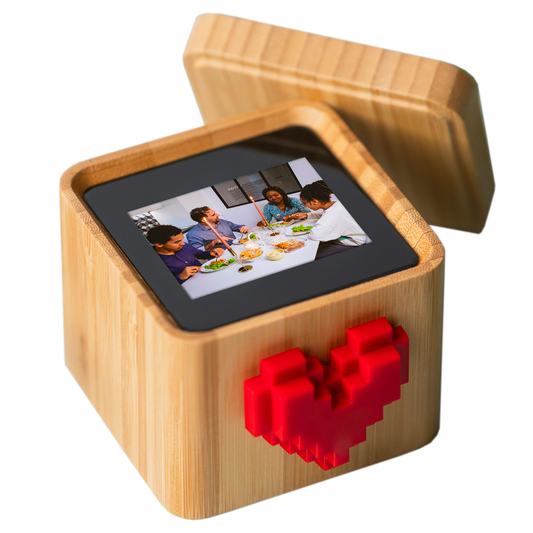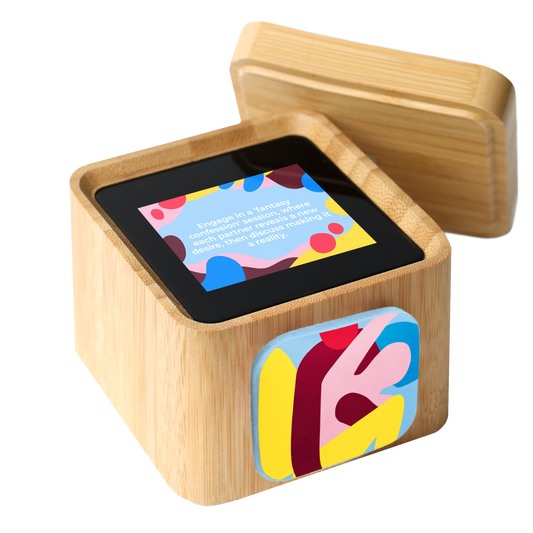In a world filled with phones and fast connections, we know how challenging it can be for divorced parents to stay close to their children without relying on phones or tablets. Navigating post-divorce parenting is a journey, and we're here to help you with a thoughtful and intentional approach. This blog post is all about "Phone-Free Parenting," offering creative and practical ways for you to communicate with your child after divorce without phones. Let's explore together how non-invasive digital alternatives can not only fill the communication gap but also build a lasting emotional bond. Join us as we discover the power of intentional communication, focusing on innovative solutions like Lovebox—a special device that turns every interaction into a moment of love and joy. Welcome to a world where parenting goes beyond phones, embracing the simplicity of heartfelt gestures and genuine expressions of love.
Effective Ways to Communicate with Your Child After Divorce
The Pitfalls of Digital Dependency
The Risks of Smartphone Use for Children: Navigating Digital Parenting After Divorce
While technology undoubtedly offers numerous benefits, it's crucial to acknowledge the potential risks associated with giving smartphones to children, especially at a young age. Here are some significant concerns that emphasize the importance of delaying smartphone access for your child, particularly in the context of communicating with your child after divorce:
1. Smartphone Addiction:
Smartphones can be highly addictive, and this addiction is not limited to adults. Research suggests that smartphone apps are designed to keep users engaged for extended periods, acting almost like a virtual slot machine. The constant urge to check the device can interfere with a child's daily activities, impacting their concentration and overall well-being.
As adults, we recognize the challenge of managing our own screen time. For children, who are still developing self-control, the addictive nature of smartphones poses a potential risk to their mental and emotional health.
2. Brain Development:
Studies conducted by the National Institute of Health indicate that prolonged smartphone use, particularly exceeding seven hours a day, can lead to significant changes in a child's brain structure. Excessive screen time has been linked to premature thinning of the cortex, the part of the brain responsible for processing information.
While it might be possible for parents to regulate screen time, introducing such potential risks at a young age raises concerns. Delaying smartphone access until children are more mature allows for better self-control and a reduced risk of adverse effects on brain development.
3. Cyberbullying:
The rise of cyberbullying is a growing concern in the digital age. Children with smartphones are more susceptible to online bullying due to increased access to the internet and social media platforms. Research indicates that children receiving smartphones in elementary school are more likely to be involved in cyberbullying.
Considering the alarming statistics—42% of kids being victims of cyberbullying—waiting until a child is more emotionally mature, possibly until the 8th grade, reduces their exposure to this harmful online behavior.
4. Pornography and Sexting:
Access to the internet through smartphones has made it easier for children to encounter explicit content, including pornography. Studies reveal that a significant percentage of children have been exposed to explicit material online, with the age of exposure dropping to as low as 14 years old.
Additionally, there is a rising concern about sexting, where children may share explicit images or messages.
In the context of post-divorce parenting, being mindful of these risks becomes crucial as we seek alternative ways to communicate with our children after divorce that do not involve the potential pitfalls of early smartphone exposure.
Delaying smartphone access helps mitigate the risk of children stumbling upon inappropriate content and engaging in behaviors like sexting before they have the emotional maturity to comprehend the consequences.
Negative Effects of Excessive Screen Time on Children: Communicate with Your Child After Divorce
In the era of digital technology, children are increasingly exposed to screens, and the consequences of excessive digital time are well-documented. It is crucial for divorced parents to recognize these negative effects to make informed decisions about communication methods:
- Impaired Social Skills: Excessive screen time can hinder the development of crucial social skills in children. Face-to-face communication becomes essential for fostering healthy relationships, and divorcing parents should seek alternatives to maintain this aspect of their child's development.
- Reduced Emotional Connection: Screen-based communication lacks the depth and emotional resonance that in-person or more tangible forms of interaction provide. Children may struggle to connect emotionally with their parents through digital means alone.
- Sleep Disruption: Prolonged exposure to screens, especially before bedtime, can disrupt sleep patterns in children. With divorced parents navigating shared custody, it's vital to consider the potential impact of digital devices on a child's sleep routine.
Emphasizing the Need for Personal and Thoughtful Communication: Communicate with Your Child After Divorce
While digital communication has become ubiquitous, divorced parents should be aware of the need for more personal and thoughtful approaches in their interactions with their children:
- Quality Over Quantity: Rather than relying solely on the quantity of digital messages, divorced parents should focus on the quality of communication. Meaningful interactions, even if less frequent, can have a more positive impact on the parent-child relationship.
- Understanding Emotional Cues: Digital communication often lacks the nuance of non-verbal cues that are crucial for understanding emotions. Parents should be mindful of these cues and seek alternatives that allow for a richer emotional connection.
- Building Trust Through Tangible Means: Trust is a vital component of any parent-child relationship. Divorced parents can build trust by opting for communication methods that go beyond the digital realm, fostering a sense of reliability and consistency.
Recognizing these pitfalls is the first step for divorced parents looking to navigate post-divorce communication effectively. By understanding the limitations of digital communication, parents can explore alternative methods that promote healthier relationships and support their child's emotional well-being.
Introducing Lovebox as a way to communicate with your child after divorce
Introducing Lovebox as a Non-Invasive Digital Solution for Effective Communication After Divorce
In the quest for effective, non-invasive digital communication after divorce, Lovebox emerges as a unique and innovative solution that fosters connection in a thoughtful and tangible way.
- How does the Lovebox work? Lovebox is a physical communication device designed to bridge the gap between divorced parents and their children without resorting to screens. This small, elegant box serves as a modern take on the classic love note, incorporating technology to deliver messages in a heartwarming and engaging manner.
- Simple, Cute and User-Friendly: One of Lovebox's key features is its simplicity. Divorced parents can easily send messages to their children through a dedicated mobile app. The intuitive interface ensures that both parents and children can navigate the technology with ease, making it accessible for users of all ages.
-
Surprise Element: Lovebox adds an element of surprise to communication. When a message is received, the heart on the front of the box spins, alerting the child to check for a new message. This element of anticipation and surprise brings joy to the communication process, making it more engaging and memorable.
In the realm of communicating with your child after divorce, Lovebox stands out as an innovative and user-friendly solution, redefining how divorced parents can foster connection through meaningful and non-invasive digital means.
Far from the eyes, close to the heart ❤️
The Lovebox for Kids is a connected, messaging device that pairs with an app to go beyond regular communication and deliver instant expressions of affection from a distance. Fun and easy to use for kids, the Lovebox is the greatest way to connect with children by sending them cute messages, stickers, drawings, and pictures.
Lovebox stands out as a non-invasive digital solution that addresses the pitfalls associated with digital communication. By offering a tangible and interactive experience, Lovebox helps divorced families create a positive and memorable channel for communication.
✅ Simple and User-Friendly
✅ Perfect way to stay connected with your little ones
✅ Give parents more control
Lovebox for divorced parents
Lovebox is particularly well-suited for divorced parents seeking a meaningful and screen-free way to stay connected with their children. Its features cater to the unique challenges of post-divorce communication, providing a bridge between physical and digital communication methods.
Lovebox success stories
Diving into Lovebox success stories in the context of intentional communication offers real-world examples of how this tangible device can facilitate meaningful exchanges between divorced parents and their children. These heartwarming stories highlight the transformative power of intentional communication, showcasing how it strengthens familial bonds. Discover how Lovebox has become a beacon for parents seeking unique ways to communicate with their child after divorce, turning ordinary moments into extraordinary connections.
⭐️⭐️⭐️⭐️⭐️ "Love this. It keeps me and my kids engaged in a fun and exciting way. When I see the heart "beating" it brings a little skip to my mama heart!!"
⭐️⭐️⭐️⭐️⭐️ "Had a business trip that took me away for a month. Bought a Love Box to share notes and pictures with my kids. It’s the first thing they look for when they wake up, and when they come home from school. Great Idea"
⭐️⭐️⭐️⭐️⭐️ "I love this so much! A great way to shower my kids with love. They absolutely love it!"
⭐️⭐️⭐️⭐️⭐️ "We love these! Got them for my kids, nephew, great grandpa and grandma and they don’t get old. It’s such a fun way for us all to communicate without social media/computers, etc."
Creative Communication Activities
Building Emotional Connections Without Screens
Nurturing and cultivating emotional connections with your child after divorce is of utmost importance. Embracing creative communication activities provides divorced parents with a unique opportunity to communicate with your child after divorce and foster emotional bonds without relying on screens.
- Writing Letters and Notes: Penning heartfelt letters or notes to your child allows for a personal touch that digital messages often lack. Whether sharing thoughts, memories, or simply expressing love, a tangible letter carries a profound emotional impact.
- Shared Journaling: Create a shared journal where both parents and the child can jot down thoughts, experiences, or drawings. This interactive journal becomes a collaborative space, fostering a sense of togetherness despite physical separation.
- Surprise Packages or Postcards: Sending surprise packages or postcards through traditional mail can be an exciting and memorable experience for children. It adds an element of anticipation, and the physicality of receiving a tangible item reinforces the emotional connection.
Creative Ways to Connect with Your Child After Divorce
Diversifying communication methods beyond the digital realm opens up opportunities for creativity and deeper connection:
- Audio Recordings: Recording messages or stories in your own voice adds a personal and comforting dimension to communication. Children can listen to these recordings whenever they need reassurance or simply want to hear a familiar voice.
- Virtual Storytime: Embrace technology in a controlled and purposeful manner by organizing virtual storytime sessions. Share a favorite book or create your own stories together, maintaining the bedtime ritual even from a distance.
-
Artistic Collaborations: Encourage artistic expression by engaging in collaborative art projects. Whether it's drawing, painting, or crafting, these shared activities not only create lasting memories but also serve as tangible reminders of the bond between parent and child.
In navigating the complexities of post-divorce parenting, these creative and non-digital methods to communicate with your child after divorce become invaluable, fostering a deep and meaningful connection that withstands the challenges of physical separation.
Establishing Routine and Flexibility
In the realm of post-divorce communication, finding a delicate balance between establishing routine and embracing flexibility is crucial for communicating with your child after divorce. This balance ensures that communication remains consistent and meaningful while adapting to the dynamic nature of co-parenting.
Daily Routines for Communication in Digital-Free Parenting
- Scheduled Check-Ins: Set specific times for check-ins, whether through Lovebox messages, letters, or other creative means. Consistency in these check-ins provides a sense of routine for children, offering predictability in the midst of changes.
- Morning and Bedtime Rituals: Incorporate communication into morning and bedtime routines. Whether it's a quick note to start the day or a reflective message before bedtime, these rituals create comforting anchors for both parents and children.
- Weekly Updates: Designate a day or time each week for more comprehensive updates. This could include sharing highlights of the week, discussing upcoming events, or even planning activities for the future. Regular, structured updates foster a sense of continuity.
Balancing Routine and Flexibility in Non-Digital Co-Parenting
- Flexibility in Communication Methods: While establishing routines, remain flexible in the choice of communication methods. Allow room for spontaneous messages, surprise packages, or unplanned interactions to add a touch of spontaneity and joy to the routine.
- Adapting to Changing Schedules: Recognize that schedules may change due to various factors, such as school events, extracurricular activities, or holidays. Be adaptable and communicate openly about adjustments to routines to accommodate these changes.
- Shared Calendar Systems: Utilize shared calendar systems to coordinate schedules and plan communication times. This not only ensures that both parents are on the same page but also provides a visual representation of the routine, aiding in better planning.
Positive Impact of Non-Digital Communication
In the landscape of post-divorce communication, communicating with your child after divorce by embracing non-digital methods offers a plethora of advantages, fostering positive outcomes for both parents and children. Recognizing the profound impact of these non-digital interactions is essential for divorced parents seeking to nurture strong and healthy relationships.
Maintaining a Strong Parent-Child Bond After Divorce
- Emotional Depth: Non-digital communication allows for a depth of emotion that can be challenging to convey through screens. Letters, notes, and physical artifacts carry a tangible and emotional weight, contributing to a more profound parent-child bond.
- Presence and Connection: By opting for non-digital alternatives, divorced parents can convey a sense of presence even when physically apart. The effort invested in tangible communication methods reinforces to the child that they are valued and cherished.
- Consistency in Expression: Non-digital communication methods provide a consistent means of expression that remains unchanged by the volatility of digital platforms. The permanence of a written letter or a shared journal entry creates lasting memories and a sense of stability.
Intentional and Meaningful Communication
In the realm of post-divorce parenting, intentional and meaningful communication becomes the cornerstone for building and sustaining a healthy relationship between divorced parents and their children. This intentional approach transcends the digital landscape, emphasizing depth, thoughtfulness, and purpose in every interaction.
Intentional Communication Strategies for Divorced Parents
- Setting Clear Intentions: Before engaging in communication, divorced parents should set clear intentions. Whether expressing love, providing support, or sharing updates, knowing the purpose of the communication enhances its impact and relevance.
- Active Listening: Intentional communication involves active listening. Divorced parents should listen attentively to their child's thoughts, feelings, and concerns, fostering an open and supportive environment that transcends the limitations of digital exchanges.
- Addressing Specific Needs: Recognizing the unique needs of the child and tailoring communication to address those needs is crucial. Whether it's reassurance, guidance, or simply sharing daily experiences, intentional communication meets the child where they are emotionally.
Exploring alternatives to phone communication for divorced parents
Investigating various alternatives to phone communication underscores the intentionality behind seeking non-invasive digital methods. It demonstrates a commitment to fostering intentional and meaningful connections that go beyond the convenience of digital platforms.
In the pursuit of intentional and meaningful communication, divorced parents lay the groundwork for a relationship characterized by depth, understanding, and mutual respect. By infusing intentionality into every interaction, parents contribute to the emotional well-being of their children and create a communication framework that transcends the challenges of divorce, fostering a resilient and enduring connection.
It becomes evident that meaningful communication with our children after divorce doesn't require a constant digital tether. By stepping away from screens and embracing intentional, creative alternatives, we open doors to a world where genuine connections flourish. The power of a heartfelt letter, a shared journal, or a surprise package can surpass the immediacy of a text message and leave lasting impressions on our children's hearts.
In the pursuit of effective communication, Lovebox emerges as a beacon, offering a tangible and innovative solution to bridge the physical gaps between parents and children.Its simplicity and charm redefine the way we communicate with your child after divorce, fostering moments of joy and love that transcend the limitations of a digital interface.
As divorced parents, we understand the complexities of our roles, but by committing to consistent, creative, and phone-free communication, we unlock the potential to build stronger, more resilient relationships with our children. Let this journey be a reminder that the essence of parenting lies not in the devices we use but in the authenticity of our expressions, the intentionality of our gestures, and the enduring power of love.
In a world where phones often dominate our interactions, let us celebrate the beauty of simple, non-invasive digital communication that stands the test of time, proving that the truest connections are formed through genuine moments of presence, care, and love. Here's to embracing a phone-free parenting approach that nurtures bonds that last a lifetime.
What is Lovebox, and how does it contribute to phone-free parenting after divorce?
Lovebox is a tangible communication device designed for phone-free parenting. It allows divorced parents to send messages to their children in a phone-free manner. The device features a spinning heart that alerts the child to check for a new message, adding an element of surprise and joy to the communication process.
How can I establish a routine for communication without relying on phones after divorce?
To establish a routine for digital-free communication, consider scheduled check-ins, morning and bedtime rituals, and weekly updates. These routines provide consistency and predictability for both parents and children, fostering a sense of stability in the post-divorce dynamic.
Are there creative communication activities beyond Lovebox that I can explore?
Absolutely! Beyond Lovebox, you can explore creative activities such as writing letters and notes, shared journaling, sending surprise packages or postcards, engaging in audio recordings, virtual storytime sessions, and artistic collaborations. These activities add a personal touch and depth to communication
How do non-digital communication methods positively impact children after divorce?
Non-digital communication methods, such as handwritten letters and shared activities, have a profound positive impact on children. They contribute to emotional depth, reinforce a sense of presence, and provide consistency in expression. These methods help maintain a strong parent-child bond post-divorce.
How do I connect with my child after divorce?
Connecting with your child after divorce is a process that requires patience, understanding, and intentional efforts. Here are some suggestions to help you foster a strong and meaningful connection:
Open Communication:
Encourage open and honest communication. Create a safe space for your child to express their feelings, thoughts, and concerns without judgment. Be a good listener and validate their emotions.
Quality Time:
Spend quality time together. Whether it's participating in shared activities, going for outings, or simply having a quiet evening at home, dedicating time to bond strengthens your connection.
Consistency in Routine:
Establish a consistent routine for communication and visitation. Predictability provides stability for your child during a period of change. Stick to agreed-upon schedules to build a sense of reliability.
Be Present:
When you are with your child, be fully present. Put away distractions like phones or work-related matters and focus on the time spent together. Your undivided attention speaks volumes.
Support Their Relationships:
Encourage and support your child's relationships with the other parent and extended family. Demonstrate a cooperative and positive co-parenting attitude to create a nurturing environment.
Create New Traditions:
Establish new traditions or rituals that are unique to your relationship. These could be as simple as a weekly movie night, cooking together, or a special outing. Building shared experiences strengthens your bond.
Respect Their Feelings:
Respect your child's feelings towards the divorce. Acknowledge that it might be a challenging time for them, and offer reassurance that your love and support remain unwavering.
Empower Independence:
Empower your child to make choices and express their preferences. Allowing them to have a say in certain decisions helps build a sense of control and autonomy.
Seek Professional Support:
If needed, consider involving a professional, such as a family therapist or counselor, to provide guidance and support for both you and your child during the adjustment period.
Celebrate Achievements:
Acknowledge and celebrate your child's achievements, no matter how small. Positive reinforcement boosts their self-esteem and reinforces the idea that you are actively engaged in their lives.
Remember that building or rebuilding a connection takes time, and patience is key. By consistently demonstrating love, understanding, and a commitment to your child's well-being, you can create a strong and enduring connection after divorce.
I’m a divorced parent. What’s the best way to talk to my kids?
Communication is key, especially after a divorce. Choose a comfortable and neutral environment for discussions. Be empathetic, encourage open dialogue, and assure your children that their feelings are valid. Listen actively and avoid placing them in the middle of any conflicts.
How can I stay in touch with my child without a phone?
Staying in touch without a phone is not only possible but can also be enriching. Consider creative alternatives such as handwritten letters, shared journals, surprise packages, the Lovebox for kids or dedicated virtual sessions. This way, you can maintain a strong connection without the need for smartphones.
How can i educate my child about online safety without scaring them?
Approach online safety education with age-appropriate discussions. Emphasize the importance of privacy, responsible sharing, and respectful online behavior. Use real-life examples to illustrate potential risks, ensuring your child understands the importance of being vigilant without instilling fear.
What are some fun and educational screen-free activities i can engage in with my child?
There are plenty of engaging activities to enjoy with your child that don't involve screens. Consider outdoor adventures, board games, reading together, cooking, arts and crafts, or even learning a new hobby. These activities not only strengthen your bond but also contribute to your child's holistic development.
















